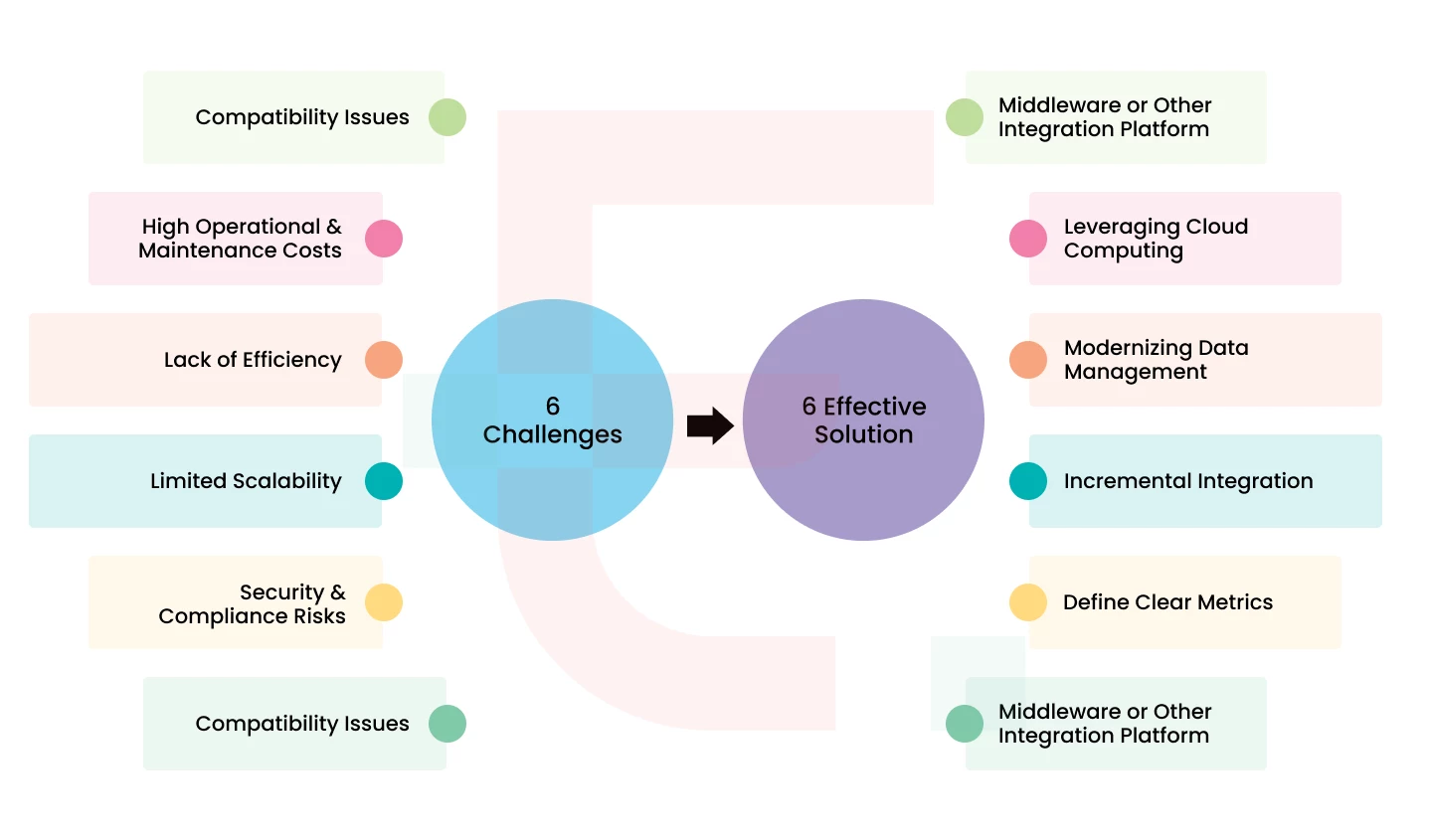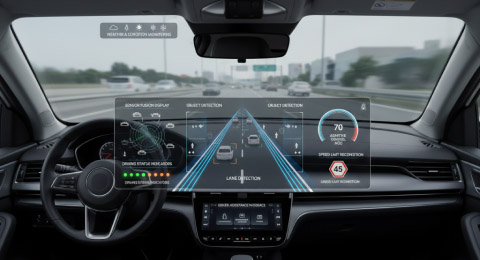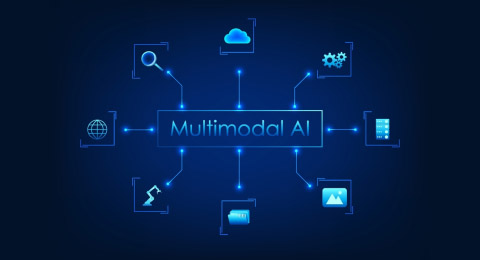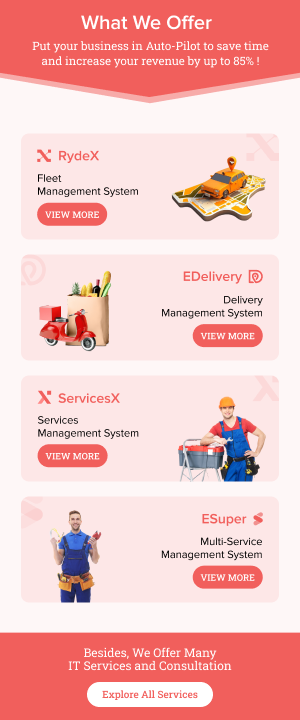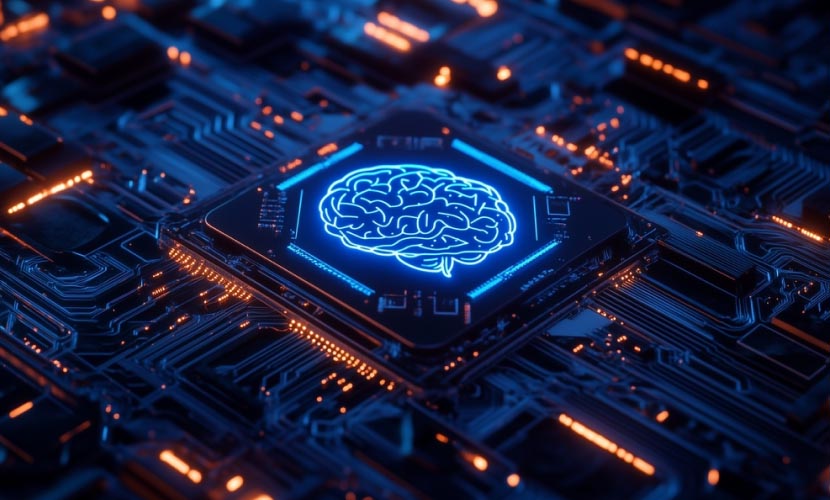
In this era of artificial intelligence, businesses can no longer let outdated systems hinder progress. Legacy systems, once reliable, have become silent roadblocks that limit innovation. Businesses require smart technologies to unlock efficiency, reduce costs, and improve decision-making, and this is where integrating AI into legacy systems becomes essential.
- What is a Legacy System? Why Is It Essential for Businesses to Upgrade It?
- How can Businesses Overcome the Key Challenges of Integrating AI into Legacy Systems?
- How AI is Transforming Legacy Systems Across Industries – Let’s Discuss Some Real-World Examples
- Conclusion
- FAQs
- What are the 6Cs for identifying and evaluating legacy systems?
- What are the benefits of integrating AI into legacy systems?
- What is the future of AI for legacy system modernization?
- What is the difference between legacy app modernization and legacy system modernization?
- Which type of AI tools should be utilized for integrating with the existing legacy system?
- What are the essential steps for integrating AI into legacy systems?
However, modernizing legacy systems with AI comes with challenges, including compatibility issues, data quality concerns, and organizational readiness. A thoughtful and strategic approach is required to overcome both technical and organizational hurdles while ensuring a smooth transition to intelligent, adaptive operations.
In this comprehensive blog, we will walk you through what legacy systems are and explore effective solutions to overcome the challenges of integrating AI into legacy systems.
What is a Legacy System? Why Is It Essential for Businesses to Upgrade It?
A legacy system refers to outdated computing software or hardware systems that are still in use. Despite its rigidity, difficulty in scaling, and other drawbacks, it continues to be used by many enterprises because it helps them handle critical operations, store a vast amount of data, or is too costly and risky to replace entirely.
Legacy systems are the backbone of many critical operations, and we all agree on it to some extent. However, in this digital era, many businesses face challenges because their older legacy systems do not allow them to grow effectively.
Surprisingly, around 92% of businesses rely on outdated technologies, which hinder their growth and prevent them from scaling effectively in today’s modern era.
Before learning about the major challenges and their solutions for integrating AI into legacy systems, we provide some of the key benefits that businesses gain by modernizing their decades-old legacy systems.
Benefits of Integrating AI into Legacy Systems:
Cost Efficiency:
With an older legacy system, there are no direct costs, but hidden expenses arise from addressing compatibility issues, inefficiencies, and other problems. However, upgrading and incorporating AI into legacy systems can help businesses save money by reducing operational costs while maintaining streamlined processes.
Improve Productivity:
Leveraging outdated legacy software can result in slow operations, as its functionality is limited. But by upgrading the system with AI, businesses can automate repetitive tasks, streamline their workflows, and enable teams to focus on high-value tasks, thereby enhancing overall productivity.
Enhanced Security:
An old system increases the likelihood of cyberattacks. According to a TechTarget survey conducted in 2025, 32% cyberattacks exploit unpatched software vulnerabilities, showcasing the risks associated with outdated systems. However, by opting for an updated system, it enhances overall business security by protecting sensitive data and minimizing the risk of data breaches.
Scalability & Flexibility:
An outdated legacy system will create some limitations to scaling and growing your business. However, AI-powered systems enable businesses to easily integrate with other applications and make other business-required changes effectively as per the evolving needs of the market.
How can Businesses Overcome the Key Challenges of Integrating AI into Legacy Systems?
AI integration into legacy systems isn’t as simple as flipping a switch. Many businesses still rely on decades-old systems built for an entirely different era of computing. While AI promises automation, enhanced business efficiency, and smarter decision-making, these outdated apps weren’t designed to handle such advancements.
Now, let’s briefly discuss the roadblocks that are stopping businesses from upgrading and also take a closer look at effective solutions for overcoming them.
1. Compatibility Issues:
One of the major challenges of integrating AI into legacy systems is the issue of compatibility. The old system often runs on outdated architectures, making AI integration a technical headache.
It may struggle to process large datasets, connect with modern APIs, and create a gap between new AI models and existing software, leading to significant hurdles in modernization, such as increased downtime and delays in integrating AI directly into outdated systems.
Solution – Middleware or Other Integration Platform
An effective way to overcome this challenge is to utilize middleware or other integration platforms, which serve as a bridge between legacy systems and AI tools. It enables seamless communication between new AI models and existing systems without requiring a complete system rebuild.
- Effectively implement API gateways for standardized data exchange between old legacy systems and AI models.
- Utilize the middleware platform to act as a bridge between legacy and AI models.
- Update individual components to enhance compatibility over time.
- Enable real-time data translation for AI tools to operate effectively.
2. High Operational & Maintenance Costs:
In the digital era, maintaining outdated versions is expensive. The cost may increase due to updating old hardware, dual maintenance, which involves both old and new systems, and other related expenses, directly impacting their overall business budget.
In fact, many businesses also believe that integrating AI and implementing it may cost them higher; but, they often overlook the hidden expenses of maintaining a decades-old legacy system.
Solution – Leveraging Cloud Computing
The best way to overcome this challenge is by leveraging cloud computing. It helps businesses reduce operational and maintenance costs by providing scalable, on-demand infrastructures, allowing AI models to run effectively without the heavy upfront investment required.
- Instead of upgrading old hardware, utilize cloud-based AI platforms.
- Scale resources as per your business requirements.
- Connect with a cloud service provider to outsource maintenance, updates, and security-based issues.
- Optimize cloud infrastructures to reduce energy and operational costs.
3. Lack of Efficiency:
Legacy systems often store data in silos, adhere to outdated formats, and have a slow processing speed, which reduces their overall efficiency. However, AI requires a clear and structured data format to generate accurate results.
The risk of generating incomplete or inconsistent data is higher, leading to inaccurate AI-driven results that impact the overall decision-making and operational performance of the business.
Solution – Modernizing Data Management
To address this obstacle, data management is being modernized. AI systems have access to deliver accurate and structured data, resulting in improved business efficiency.
- Obtaining data in a clear and standardized format to enhance AI accuracy.
- Effectively centralized data to eliminate silos and enable better accessibility.
- Implement real-time data to make the process even faster and error-free.
- The data format must be well-structured so that AI models can interpret the details more accurately.
4. Limited Scalability
Most legacy systems are unable to adapt to evolving market requirements, creating hurdles for businesses to grow and remain competitive in this era.
In fact, when AI modules are introduced, the system may experience performance issues, such as solution overloading, which negatively impacts its overall operations and limits its ability to expand into new markets.
Solution – Incremental Integration
To enhance your business’s scalability and extend its reach, we offer an effective solution, which is incremental integration. It helps businesses scale with AI by following a step-by-step module, ensuring stability and performance while also modernizing legacy systems.
- Monitor overall system performance by adding AI modules in each essential phase.
- Enhance the overall infrastructure with AI deployment.
- Develop a high-impact framework to demonstrate your values effectively.
- Follow a continuous test and optimize the process to scale the business without any hurdles.
5. Security & Compliance Risks
One of the major concerns when integrating AI into legacy systems is the risk of security and compliance. The older system increases the chances of more cyberattack threats, as it doesn’t follow modern security protocols.
Moreover, regulatory standards, such as the GDPR or HIPAA, require the effective handling of sensitive data, which automatically doubles the risks associated with integrating AI efficiently.
Solution – Define Clear Metrics
The better solution to overcome this challenge is to define strategic metrics, governance policies, and compliance that ensure AI integration remains secure and able to meet all the regulatory standards set by the governments.
- Secure AI-driven processes by utilizing data encryption and multi-factor authentication (MFA).
- Frequently update compliance documentation to meet the new regulatory requirements.
- Implement zero-trust security models to protect AI integrations and ensure robust security.
- Analyze AI outputs and potential risks in advance to ensure informed decision-making.
6. Resistance to Change
Regardless of whether an AI integration is technically feasible in the legacy system, human resistance is one of the reasons that delays the process of AI adoption.
Employees often prefer to work with familiar workflows, and they feel hesitant to adopt AI-powered automation, which can negatively impact decision-makers and reduce ROI.
Solution – Providing Training & Support
Seamlessly overcome this roadblock by providing effective training, support, and a strategic partnership to your employees. It helps them overcome resistance by educating staff, building confidence, and facilitating an easy transition to AI-powered workflows.
- Train your employees to help them understand the benefits of integrating AI into legacy systems.
- Step slowly towards AI implementation. That is, implement small AI tools, such as chatbots and predictive analytics.
- Demonstrate measurable results to build confidence.
- Connect with AI experts to receive proper guidance on developing effective AI strategies.
Maximize Your Business Growth by Integrating AI into Legacy Systems – Enhance Efficiency with Minimal Investment.
How AI is Transforming Legacy Systems Across Industries – Let’s Discuss Some Real-World Examples
Many leading brands across various industries have effectively modernized their legacy systems using AI, resulting in increased efficiency and a competitive advantage. Let’s take a quick look at some real-world examples below.
McDonald’s
As one of the renowned fast-food chains, McDonald’s serves millions daily through outdated ordering and kitchen systems. By integrating AI into its legacy point-of-sale (POS) and drive-thru systems, it has enhanced both speed and the scope of personalization for its customers.
They effectively utilized voice recognition and recommendation engines to enhance their services, delivering a personalized order experience, and to streamline their kitchen workflows, without disrupting their existing systems.
American Airlines
It is one of the largest examples of legacy system modernization. American Airlines has successfully modernized its legacy system by migrating its data to the cloud. With AI, systems can effectively predict aircraft maintenance needs, optimize crew scheduling, and more.
Its strategic decision has resulted in improved scalability, enhanced operational efficiency, reduced delays, and delivered a more seamless travel experience without requiring the replacement of its entire legacy infrastructure.
JPMorgan Chase
JPMorgan Chase, a prominent bank, truly sets a great example with its legacy modernization efforts. They have effectively upgraded many systems, including their core banking and trading platforms, making things simpler and more efficient.
With the implementation of AI over its existing system, it helps them analyze massive amounts of data in real-time, enhance fraud prevention, trading strategies, and more.
National Australia Bank (NAB)
National Australia Bank (NAB) is one of Australia’s largest financial institutions, which has modernized its core banking systems by shifting applications from mainframes to more scalable platforms.
This initiative enabled the National Australia Bank to achieve increased agility, efficiency, and competitiveness within a highly regulated and rapidly evolving financial sector.
Conclusion
Integrating AI into legacy systems is a complex process, but with proper planning and the use of the right tools, it can be easily managed. This blog has highlighted key challenges, such as data management and compatibility issues, and provided an effective solution for integrating AI into legacy systems, helping businesses enhance efficiency in the digital era.
At Elluminati, our AI specialists help businesses modernize with advanced AI development services. Whether you require consultation or need any support to integrate advanced technologies into your existing systems, our team will help you unlock the full potential of your business with AI.
FAQs
Code Quality, Complexity, Cost, Compatibility, Criticality, and Compliance are the 6Cs that provide a structured approach for evaluating legacy systems.
Integrating AI into legacy systems will provide you with the following benefits:
- Enhanced Performance
- Delivers Better User Experience
- Minimize Operations & Maintenance Costs
- Improves Security
The future of AI in legacy system modernization encompasses autonomous AI agents, real-time predictive analytics, process automation, adaptive maintenance solutions, and more, which make operations smarter and more responsive.
There is a key difference between legacy app modernization and legacy system modernization. Let’s check out what it is:
- Legacy app modernization involves updating a specific application with modern technologies to enhance its functionality, efficiency, and compatibility.
- Whereas, Legacy system modernization means it’s a process of upgrading the entire IT infrastructure, including hardware, software, and data, to enhance overall scalability and performance.
The following are some of the essential AI tools to consider when integrating AI with existing legacy system:
- RPA (Robotic Process Automation)
- Data Integration & ETL (Extract, Transform, Load) tools with AI
- Machine learning platforms
- AI-powered APIs
Below, we have listed some of the key steps required for integrating AI into legacy systems.
- Determine existing infrastructure and identify use cases.
- Assess data quality and accessibility.
- Select an appropriate integration approach.
- Choose the right AI tools and technologies.
- Implement AI-oriented processes effectively.
- Deploy and optimize the performance of AI models.

